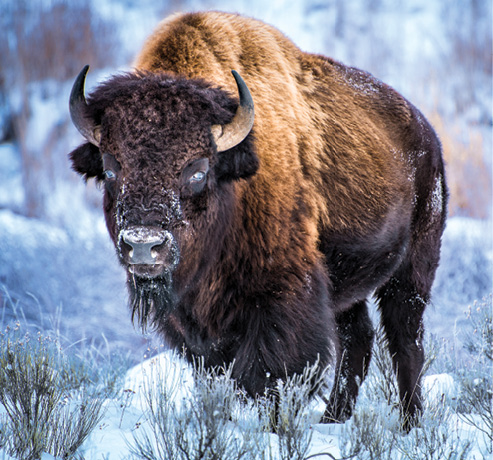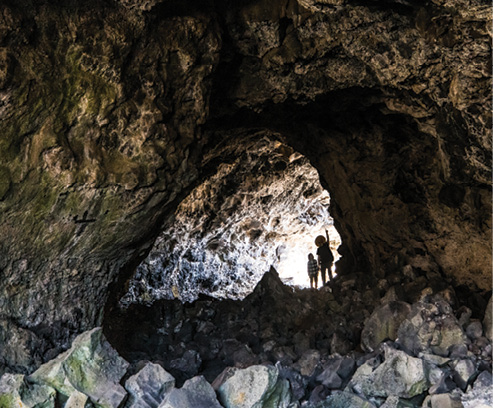National parks create another world under a blanket of snow
by Rebecca Jacobson
For many, winter in the West means a ski resort getaway. For powder paradise beyond the lift lines, head instead to one of the region’s national parks or monuments for show-stopping scenery, wildlife watching opportunities and recreation ranging from cross-country skiing to tours on big-tired snowcoaches. An added bonus? Come winter, crowd sizes dwindle, meaning visitors are likely to get some of the country’s most breathtaking sights all to themselves.
Yellowstone National Park
 Yellowstone National Park is a place of otherworldly wonders. Perched atop a behemoth supervolcano, the country’s first national park boasts geothermal marvels—from spouting geysers and sizzling fumaroles to rainbow-hued mudpots—alongside dramatic canyons and tumbling waterfalls. Charismatic megafauna, including bison, wolves and elk, roam freely. In the summer, Yellowstone teems with tourists. The park counts about 4 million visits per year, with more than half of these occurring in June, July and August. Winter, though, is an unsung gem of a season. As snow blankets the ground, crowds thin. Shaggy-haired bison lumber through the drifts—their beards crusted with icicles. (That big hump on a bison’s back? It’s muscle, allowing the animal to use its head as a snowplow.) Waterfalls freeze solid; geysers erupt into the frosty air; and the park’s iconic wolves, having traveled down from the high country, are at their most visible. The beauty and serenity are unmatched.
Yellowstone National Park is a place of otherworldly wonders. Perched atop a behemoth supervolcano, the country’s first national park boasts geothermal marvels—from spouting geysers and sizzling fumaroles to rainbow-hued mudpots—alongside dramatic canyons and tumbling waterfalls. Charismatic megafauna, including bison, wolves and elk, roam freely. In the summer, Yellowstone teems with tourists. The park counts about 4 million visits per year, with more than half of these occurring in June, July and August. Winter, though, is an unsung gem of a season. As snow blankets the ground, crowds thin. Shaggy-haired bison lumber through the drifts—their beards crusted with icicles. (That big hump on a bison’s back? It’s muscle, allowing the animal to use its head as a snowplow.) Waterfalls freeze solid; geysers erupt into the frosty air; and the park’s iconic wolves, having traveled down from the high country, are at their most visible. The beauty and serenity are unmatched.
Of Yellowstone’s five entrances, only the north gate, with its iconic Roosevelt Arch, remains open year-round. Consider posting up in Gardiner, Montana, a tiny charmer of a town with abundant lodging options just outside the park boundaries. Within the park, all unplowed roads and trails are open to skiers and snowshoers, but be prepared to push through untouched powder, as only a few miles of track are set. Plan to adjust your route if, say, you round the corner and come upon a herd of bison. Weighing up to one ton and capable of hitting 40 mph, the impressive ungulates are America’s largest land mammal and have injured more people in Yellowstone than any other animal. In other words, keep your distance.
Skiers and snowshoers setting out on their own will want to stop by the Albright Visitor Center for trail maps and condition updates. Some years, rangers lead guided snowshoe walks along the travertine terraces of Mammoth Hot Springs, where sulfur-scented steam rises from the winter white. Dozens of outfitters in the region also offer guided skiing and snowshoeing tours; find a list on the park’s website. Venture to Old Faithful, or the Grand Canyon of the Yellowstone on a snowcoach—a multi-passenger vehicle kitted out with huge low-pressure tires or snow tracks. Note: Yellowstone experienced catastrophic flooding in June 2022 and recovery remains underway. Check for potential road closures before setting out at nps.gov.
Craters of the Moon National Monument and Preserve
Halfway between Yellowstone and Boise sits another spectacular spot, where lava eruptions during the past 15,000 years have left behind vast jet-black fields of basalt alongside dozens of cinder cones. In the 1924 proclamation that made Craters of the Moon a national monument, President Calvin Coolidge called its phenomena “curious and unusual.” He described the landscape as “weird and scenic.” In 1969, Apollo astronauts trained here for lunar geology missions, and NASA continues to perform research in this remote patch of Idaho.
At 5,900 feet, winter arrives early here and brings a high-contrast scene, with bits of jagged black rock breaking through a pristine white sweep of snow. The monument’s only paved road, a scenic 7-mile loop, becomes a regularly groomed track for skiers and snowshoers. It’s relatively level, with just a few gentle hills; ski it clockwise to avoid the somewhat steep descent on the southwest flank of Inferno Cone. Skiers are also allowed to venture onto the open slopes of the cinder cones located along the Loop Road, where telemarking terrain awaits. Before carving some turns, check for evidence of other travelers. Though Craters of the Moon doesn’t boast the megafauna of Yellowstone, you might spot the delicate tracks of species ranging from deer mice and snowshoe hares to coyotes and bobcats. Stay alert, too, for the sharp “kraak” of the Clark’s nutcracker, one of the birds that toughs it out year-round.

Crater Lake National Park
On a clear day, few views are as jaw-dropping as Crater Lake in winter with its sparkling snow and crystal water, ringed by powder-dusted conifers and craggy cliffs. Other days, storms render the lake invisible, so it pays to check the forecast as well as the Rim Village webcam. America’s deepest lake, formed by the collapse of a volcano about 7,700 years ago, is also one of the snowiest places in the country, with more than forty feet of snow falling every year. Cross-country skiers and snowshoers will find a variety of marked trails and unmarked routes. None are groomed, so be prepared to break trail after fresh snowfall. The most scenic route on skis follows West Rim Drive along forested, mellow terrain, with expansive lake views arriving at Discovery Point and Wizard Island Overlook. Carry on to Watchman Overlook, about four miles from Rim Village, and exercise caution in steep spots and along the north flank of Watchman Peak where avalanches are possible. Consult the park newspaper, “Crater Lake Reflections,” for more routes. Or bring a sled—the park has no designated sled hills, but the open meadow south of Crater Lake Lodge is a popular destination. Keep an eye out for bushy-tailed pine martens and well-camouflaged snowshoe hares bounding across the path. Red foxes are also active in winter, while the Douglas squirrel—according to John Muir, “the wildest animal I ever saw”—makes an unmissable ruckus from up in the trees.
Rebecca Jacobson is a writer, editor, and teacher whose work has appeared in Portland Monthly, Willamette Week, Northwest Labor Press, and in several Wildsam field guides. She lives in Portland, Oregon.

